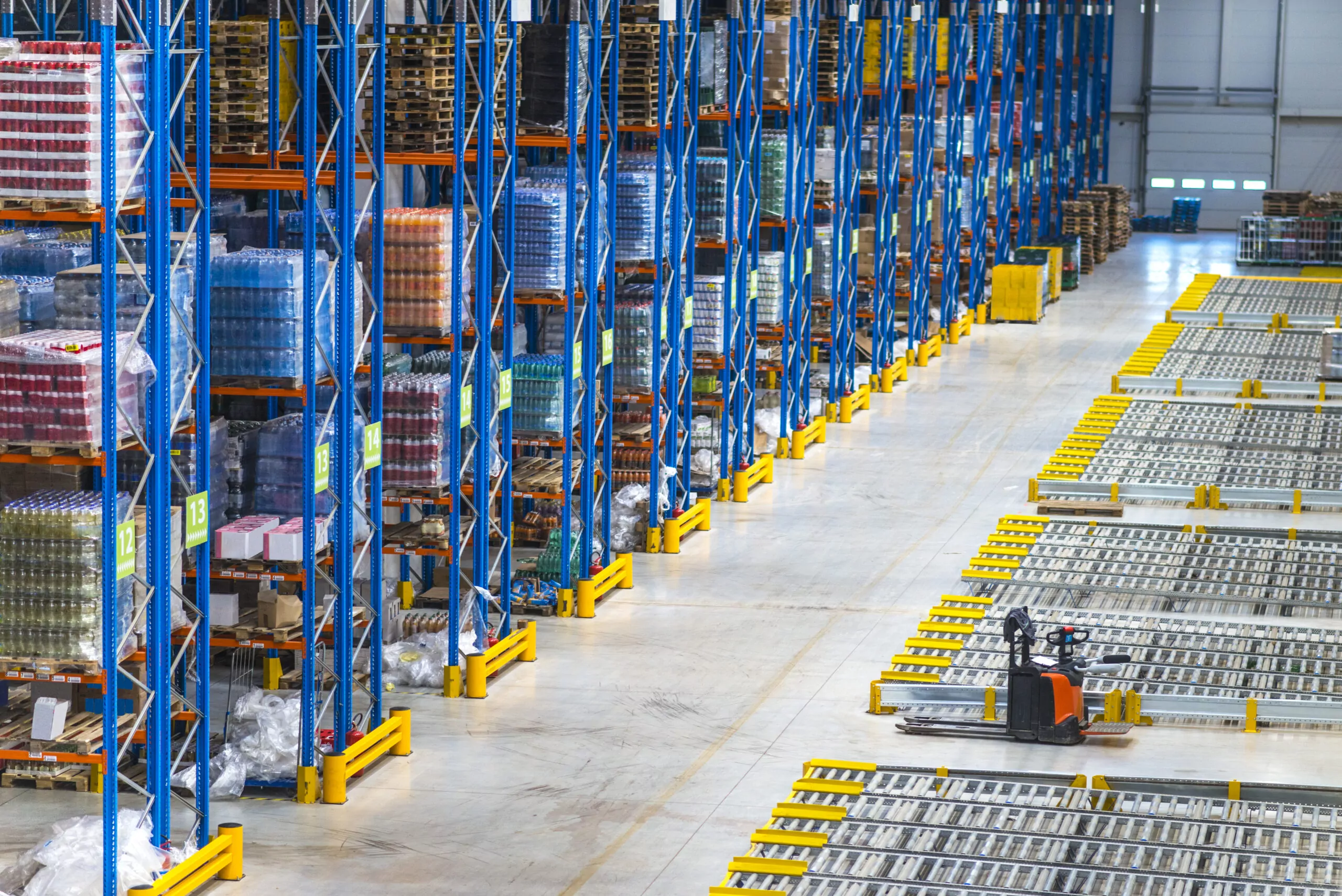Digital transformation in the supply chain
Digital transformation in supply chain management refers to the use of advanced technology to optimize and automate processes, including customer service, procurement, inventory management, and logistics. Risk management is yet another reason to turn to tech solutions when planning and monitoring supply chain processes.
Why is supply chain risk management important?
Enterprises operate within defined environments, sectors, and interconnected areas. Since no business exists in a vacuum, external factors have an impact on companies’ functioning. As a result, entities need to improve their competitiveness and resilience to outside influences. This is where supply chain risk management comes into play. Facing market disruptions such as economic changes, natural disasters, political conditions, third-party factors, and consumer needs is necessary to build an organization resilient to occurring shifts.
![distribution warehouse with trucks different capacity Digital transformation in the supply chain [Supply Chain Risk Management] 1 supply chain distribution warehouse with trucks different capacity](https://cdn.neurosys.com/wp-content/webp-express/webp-images/uploads/2023/03/distribution-warehouse-with-trucks-different-capacity-1024x767.jpg.webp)
What is digital transformation in the supply chain
Digital transformation in the supply chain relies on modern technologies used to automate and optimize the process components. Integral digital solutions from procurement to inventory management, logistics, customer service, and dispatch, integrating digital solutions help create a more efficient, sustainable, and transparent supply chain.
Why is it necessary? Efficient supply chains are the bloodstream of the global economy. The smoother the goods flow, the higher the living standards of customers worldwide, and the more strategic business objectives enterprises achieve. Since technology took various industries by storm, the growing adoption of digital tools is no surprise, with more and more advanced solutions shaping operational processes. In other words, digital transformation in logistics and supply chain management is good for the business.
According to Gartner,
over 50% of companies haven’t yet started to design their supply chain digital transformation
(1)
Why is digital transformation important for the supply chain?
Incorporating advanced technologies into the process allows for assessing the supply chain pain points and introducing corrective measures to prevent future interruptions to the supply chain.
Data-driven and tech-savvy supply chains help secure organizations against high inflation and recession risks. The 2023 Gartner report (2) recognizes four core leadership priorities in response to current challenges. Among meaders covering flawless execution of plans to improve efficiency, manage overhead costs, and strengthen planning teams to face the unfolding scenarios, the last priority is protecting vital assets. Investing in technology remains one of the core opportunities for growth, with the potential for technology improving efficiency and scalability.
Organizational priorities can vary depending on the industry, enterprise, and sole process, but there’s no doubt that digitalization fosters supply chain risk management.
To achieve the desired goals and efficiently it is necessary to respond to market disruptions, the process requires collaboration between procurement managers, enterprise risk management (ERM), and supply chain.
Benefits of digital transformation in the supply chain
Reducing costs and increasing profitability
Utilization of digital solutions allows for a significant (up to 20%) increase in revenue and reduces process costs by half, according to Gartner. Companies that maintain traditional methods in their supply chain may soon stay behind the competition and struggle with operating in the competitive market.
Increased automation
Digital transformation boosts supply chain efficiency by ceding repetitive tasks to machines, freeing the workforce from mundane work. Additionally, automation allows for a significant reduction in human error. In the broader scope, automating dispatch can reduce the decision time, with certain shipping being allocated to determined carriers, priorities, and routes.
Improving the quality of service to customers
Once the business can efficiently aggregate, manage, and analyze large data assets, the outcome delivers more excellent quality of service to clients.
Reduce lead times
Technology fosters the Just-In-Time approach, enabling efficient supply management. As a result, wait times are significantly reduced, while orders are executed in optimal timeframes.
Improving control and risk management
Digital tools can efficiently monitor processes and generate alerts whenever abnormalities are recognized. Establishing patterns for order management gives managers a path to handling orders more safely and introducing recovery plans right in time to prevent disruption in the supply chain.
Increased operational efficiency
Overseeing processes with digital tools enables making better-informed, data-driven decisions. For example, using technology to predict low stocks and peaks in demand allows companies to prepare for events before they unfold.
![consultation banner Digital transformation in the supply chain [Supply Chain Risk Management] 2 supply chain consultation banner](https://cdn.neurosys.com/wp-content/webp-express/webp-images/uploads/2023/09/consultation-banner.png.webp)
Challenges of digital transformation in the supply chain
Changing organizational culture
Aversion to change is an obstacle often seen in organizations on the verge of digital transformation. Resistance to change can affect the enterprise, slowing down necessary optimizations and endangering operational continuity. Shifting towards technology in daily operations requires a mature approach from the managerial staff, reflecting on personnel’s fears and uncertainties and addressing them thoughtfully to dispel doubts.
Data security and privacy
Utilizing AI products, cloud services, IoT devices, big data analytics, and other technologies increases operational exposure to data breaches, cyber-attacks, and other cyber security risks. The connectivity of the above-listed solutions can be the Achilles heel of the company’s operations and calls for particular attention. Risk management for supply chain transformation entails establishing compliance standards, good practices, risk assessments, backups, recovery plans, and other critical elements.
System integration and cooperation between partners
Integration and cooperation in the supply chain mean the data flows seamlessly between incorporated systems and stakeholders. As a result, planning and managing transport and logistics processes can be executed from one place, streamlining operations. However, what sounds easy, can be a nuisance to bring into force. Diverse entities operate systems that are not necessarily compatible.
Data aggregated in each organization can be contained in informational silos without established connections with other systems, making it difficult to use and integrate. In such cases, data becomes a burden to maintain instead of being the most valuable asset. Working out cross-team and cross-company integrations can be challenging and require particular attention. Only after the data containers are integrated can data from various sources serve the greater goal. The integration enables faster decision-making, convenient overview and enrichment, and better error detection.
IT infrastructure and staff qualifications
Supply chain management requires the highest levels of enterprise-grade cybersecurity solutions. From identifying and assessing human-related risks to external factors endangering the integration of supply processes, the infrastructure needs to be as robust as possible. Risk mitigation includes ensuring a high competency level across the organization, retaining expert knowledge, and enabling convenient access to standardized know-how, easy for the workforce to acquire.
Digital transformation in the supply chain – first steps
Benefits and challenges of digital transformation in the supply chain
Digital transformation carries great potential for delivering the results the market needs. Incorporating tech solutions is the way to maintain market position and secure competitiveness from one industry to another. In short, supply chain digital transformation is the path toward greater efficiency and accuracy of executed operations.
How to start your supply chain digital transformation?
Once you know it’s time to introduce digital solutions into your supply chain risk management and other aspects of the process, it’s the moment to choose a proven transformation partner. Entrusting a software provider with your operations is a big deal and we recommend doing a thorough research to find the best partner.
For more on the digital transformation of supply chains, stay tuned for our upcoming article on Supply chain 4.0 – digital transformation opportunities.
Sources
- https://www.gartner.com/en/supply-chain/topics/supply-chain-digital-transformation
- https://emtemp.gcom.cloud/ngw/globalassets/en/supply-chain/documents/trends/supply-chain-response-high-inflation-recession-risk.pdf





